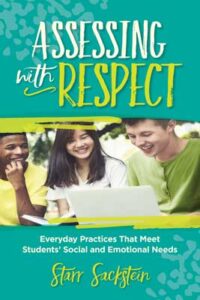Assessment That Aligns with SEL Skills and Goals
Assessing with Respect: Everyday Practices That Meet Students’ Social and Emotional Needs
By Starr Sackstein
(ASCD, 2021 – Learn more)
Reviewed by Megan Balduf

Coming to this text off of Sackstein’s Hacking Assessment, I was anticipating more advice and suggestions on how to create and deploy assessments that better match student learning – thus assessing students in a respectful manner. Despite the potential misnomer of the main title, the subtitle – Everyday Practices That Meet Students’ Social and Emotional Needs – is spot on.

She then lays out how teachers (in their classrooms) and administrators (in individual schools or full school systems) can adapt the Collaborative for Academic, Social, and Emotional Learning (CASEL) competencies – self-awareness, self-management, social awareness, relationship skills, responsible decision making – to maximize student success.
“Assessment is not a static thing, but an action” teachers continually engage in to ensure students are learning (6), she reminds us. By framing assessment around the classroom environment and the daily activities teachers provide feedback on, Sackstein establishes a pattern for her chapters: what the CASEL competency is and how teachers can create situations for the competency to thrive.
Theory and Practice
Assessing with Respect includes both the theoretical basis for the CASEL competency and real classroom examples – handouts, rubrics, policies – to aid readers in establishing spaces and routines that support students’ social and emotional needs.
Additionally, vignettes she scatters throughout each chapter show the practical implications of fostering that CASEL competency. Sackstein closes each chapter with reflection questions to help educators and administrators better address the social and emotional needs of students.
Novice teachers will find many helpful suggestions throughout the book. The four chapters dedicated to CASEL competencies (social awareness and relationship skills are in a shared chapter) lay out a number of ways to establish a classroom environment and routines.
For instance, in the chapter about building relationships Sackstein shares ways to cultivate teacher-student relationships (sending a welcome letter), student-student relationships (co-constructing a definition of respect), student-culture relationships (having students share information about their background), teacher-family relationships (having positive contacts with home), and leadership-teacher relationships (having an open-door policy).
As a veteran teacher, I found many of Sackstein’s approaches simply good teaching. For example, she includes a set of recommended due dates to help students track work as a way to facilitate self-management.
I have provided such a set of due dates when my students have a long-term project, yet I would not have considered that a respectful assessment practice. However, Sackstein’s premise is that recommended due dates show respect for students’ emotional needs because it helps them with their time management (part of executive functioning).
Most of her recommendations are based on research supporting students’ social and emotional needs. They also feel like a reflection of what teachers know works, regardless of what the research says.
Assessment’s Emotional Roller Coaster
Veteran teachers will find benefit in the reflection questions at the end of chapters as they are strong reminders of how to establish classrooms where students will thrive. Additionally, veteran and novice teachers alike could learn a lot from the chapters on grading and assessment. Many teachers recognize grades carry a certain amount of stress, both for the teacher attempting to accurately convey students’ learning via a letter or number and for the student whom society has told much hangs on their grades.
Sackstein reminds us “[i]f all of us took the time to understand the emotional roller coaster that grading creates and de-emphasized the practice, we would get more out of students” (100). Sackstein suggests reframing grades around collaboration and cooperation and looking at student growth over time (as would be shown in a portfolio).
Many of Sackstein’s tips in the final two chapters would require an overhaul of traditional grading, but small steps could be taken in individual classrooms.
Though the text was not what I assumed it would be, it had helpful information. Like with our students, having another person re-affirm what I’m thinking or doing makes me more willing to do it consistently. At its heart, Assessing for Respect is about focusing on meeting students’ emotional needs and how that allows us to work with them on greater academic achievements.
Megan Balduf (@MBalduf) is a middle school English teacher with nineteen years’ experience. Being a classroom teacher was always her dream, and her experience allowed Megan to become a teacher leader, including being part of AMLE’s Teacher Leader Constituent Committee. Since entering the classroom, Megan has earned an MA in Gifted Education and an MA in English for Language Arts Teachers, and has become a National Board Certified Teacher.



































